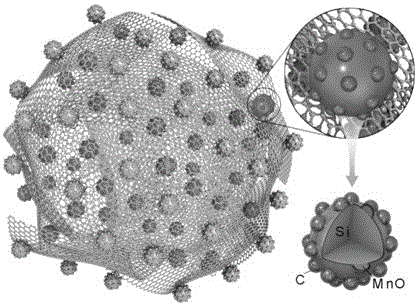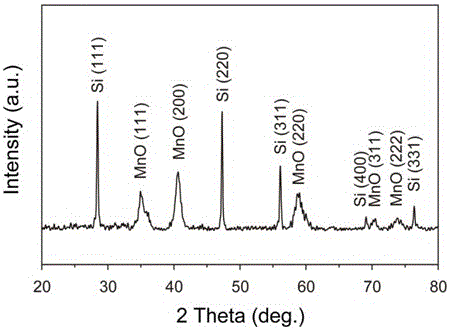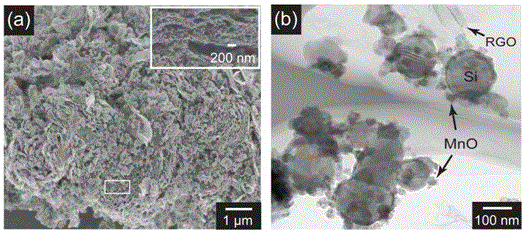Nanometer hybrid material integrating positive/negative cyclic effects and preparation method thereof
A nano-hybrid material and effect technology, applied in the field of materials, can solve the problems of silicon/carbon nanocomposite material capacity decline, limited silicon application, and shortened battery cycle life.
- Summary
- Abstract
- Description
- Claims
- Application Information
AI Technical Summary
Problems solved by technology
Method used
Image
Examples
Embodiment 1
[0026] Preparation of (Si@MnO)@C / RGO Nano-hybrid Materials
[0027] Under the condition of magnetic stirring, the manganese chloride of 0.49 g, the sodium oleate of 1.52 g are successively added in the mixed solution of 8 ml water, 14 ml ethanol and 50 ml n-hexane, after stirring at room temperature for 4 hours, the mixed solution is layered, The upper layer solution becomes a light brown manganese oleate / n-hexane solution, and the lower layer is an aqueous solution of sodium chloride. The manganese oleate / n-hexane solution in the upper layer can be separated by repeated washing with 50 ml of deionized water through a separatory funnel. Then 60 mg of silicon nanoparticles were added to the manganese oleate / n-hexane solution, and after stirring for 4 hours, 18 mg of graphene nanosheets were added, stirred for 4 hours again, and then stirred at 70 o C rotary evaporation to obtain the precursor. Finally, under the condition of high-purity nitrogen atmosphere, the precursor was ...
Embodiment 2
[0029] Preparation of (Si@MnO)@C / RGO Nano-hybrid Materials
[0030] Under the condition of magnetic stirring, the manganese chloride of 0.49 g, the sodium oleate of 1.52 g are successively added in the mixed solution of 8 ml water, 14 ml ethanol and 50 ml n-hexane, after stirring at room temperature for 4 hours, the mixed solution is layered, The upper layer solution becomes a light brown manganese oleate / n-hexane solution, and the lower layer is an aqueous solution of sodium chloride. The manganese oleate / n-hexane solution in the upper layer can be separated by repeated washing with 50 ml of deionized water through a separatory funnel. Then 40 mg of silicon nanoparticles were added to manganese oleate / n-hexane solution, and after stirring for 4 hours, 18 mg of graphene nanosheets were added, stirred for 4 hours again, and then stirred at 70 o C rotary evaporation to obtain the precursor. Finally, under the condition of high-purity nitrogen atmosphere, the precursor was prep...
Embodiment 3
[0032] Preparation of (Si@MnO)@C / RGO Nano-hybrid Materials
[0033] Under the condition of magnetic stirring, the manganese chloride of 0.49 g, the sodium oleate of 1.52 g are successively added in the mixed solution of 8 ml water, 14 ml ethanol and 50 ml n-hexane, after stirring at room temperature for 4 hours, the mixed solution is layered, The upper layer solution becomes a light brown manganese oleate / n-hexane solution, and the lower layer is an aqueous solution of sodium chloride. The manganese oleate / n-hexane solution in the upper layer can be separated by repeated washing with 50 ml of deionized water through a separatory funnel. Then 20 mg of silicon nanoparticles were added to the manganese oleate / n-hexane solution, and after stirring for 4 hours, 20 mg of graphene nanosheets were added, stirred for 4 hours again, and then stirred at 70 o C rotary evaporation to obtain the precursor. Finally, under the condition of high-purity nitrogen atmosphere, the precursor was ...
PUM
 Login to View More
Login to View More Abstract
Description
Claims
Application Information
 Login to View More
Login to View More - R&D
- Intellectual Property
- Life Sciences
- Materials
- Tech Scout
- Unparalleled Data Quality
- Higher Quality Content
- 60% Fewer Hallucinations
Browse by: Latest US Patents, China's latest patents, Technical Efficacy Thesaurus, Application Domain, Technology Topic, Popular Technical Reports.
© 2025 PatSnap. All rights reserved.Legal|Privacy policy|Modern Slavery Act Transparency Statement|Sitemap|About US| Contact US: help@patsnap.com



